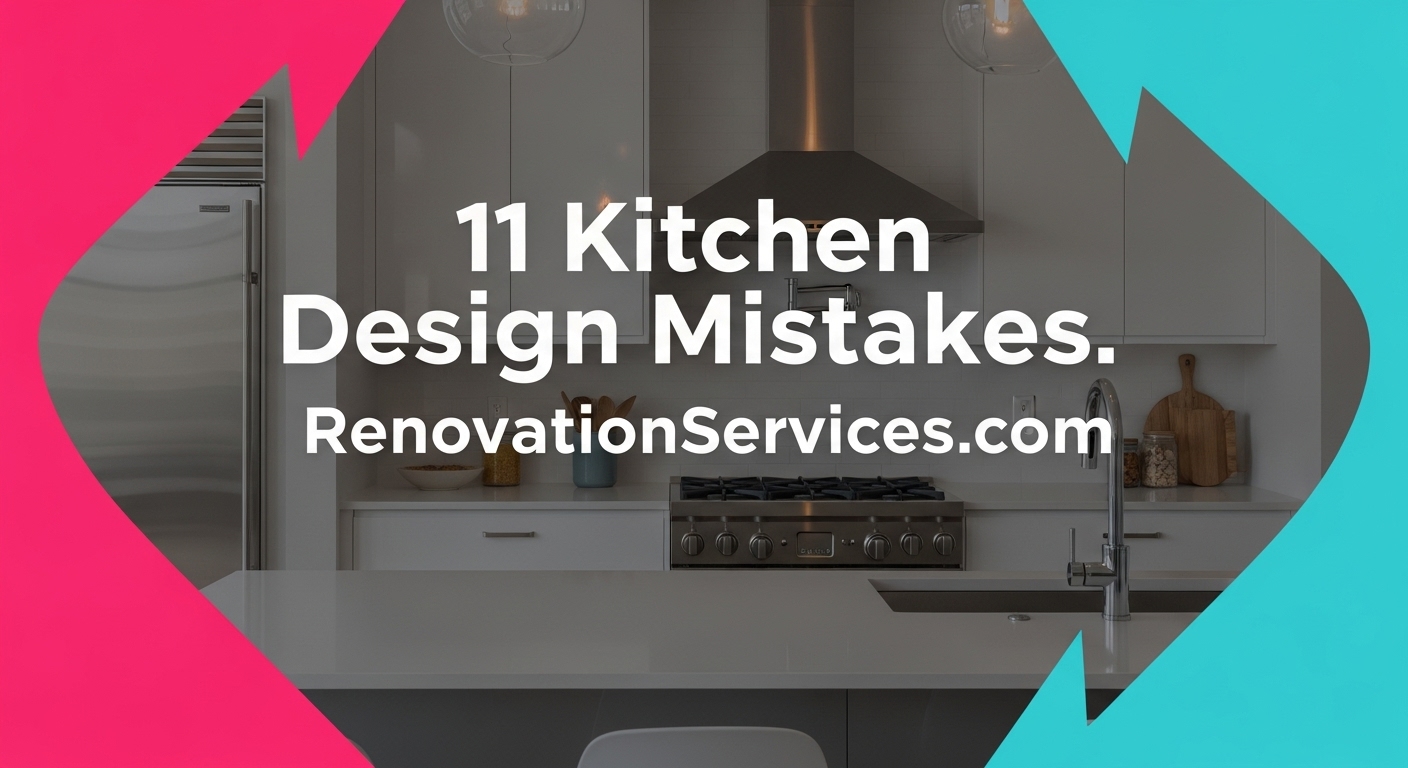N.Y. Renovation Services
11 Kitchen Design Mistakes to Avoid in Your NYC Renovation

A kitchen renovation is the most impactful project you can undertake in your NYC home. It’s a chance to create a space that’s not just beautiful, but also a joy to cook and live in. However, the difference between a dream kitchen and a daily frustration often comes down to small, overlooked details. Poor planning can lead to cramped workflows, wasted space, and a design that feels dated before its time.
To help you create a kitchen that truly works, we’ve compiled a list of the 11 most common design mistakes we see in NYC renovations—and more importantly, how to fix them. From optimizing your layout to choosing the right materials, this guide will empower you to make smarter decisions for your kitchen remodel. And if you need an expert eye, the team at RenovationServices.com is here to guide you.
1. Ignoring the Kitchen Work Triangle
The Mistake
The kitchen work triangle is a classic design principle that dictates the placement of the three main work areas: the sink, the refrigerator, and the cooktop. A poorly planned layout places these elements too far apart or obstructs the path between them, leading to an inefficient and frustrating cooking experience.
The NYC-Specific Challenge
In the often-compact kitchens of Manhattan apartments or the narrow galleys of Brooklyn brownstones, creating an ideal work triangle can be challenging. An island can become an obstacle rather than an asset if it blocks the direct path between the sink and the stove.
The Fix
Map out the triangle. The sum of the three sides should be no more than 26 feet, with each leg measuring between 4 and 9 feet. Ensure no major traffic patterns cut through the triangle. If you have an island, consider placing the sink or cooktop in it to create a more efficient workflow. For more layout ideas, check our guide to kitchen trends.
2. Wasting Storage Space
The Mistake
Many kitchen designs fail to maximize vertical space or utilize hard-to-reach corners, leading to wasted storage potential. Standard cabinets often leave a gap above that collects dust, and deep corner cabinets become black holes where items are lost forever.
The NYC-Specific Challenge
Storage is the ultimate luxury in any NYC home. Every cubic inch counts. Failing to use the space up to the ceiling or not investing in smart corner solutions is a major missed opportunity in a city where space is at a premium.
The Fix
Take your upper cabinets all the way to the ceiling to store lesser-used items. For base corners, install a Lazy Susan or pull-out shelving system that brings the contents to you. Use drawer dividers, pull-out pantry units, and toe-kick drawers to find storage in every possible nook. Our guide to avoiding renovation mistakes offers more storage solutions.
3. Poor Lighting Design
The Mistake
Relying on a single, central ceiling fixture is one of the most common kitchen lighting mistakes. This creates shadows on your countertops exactly where you need to see what you’re doing, making food prep difficult and even dangerous.
The NYC-Specific Challenge
Many older NYC apartments lack overhead lighting entirely, relying on lamps. When renovating, it’s the perfect time to correct this, but it must be done thoughtfully. Simply adding a central fixture won’t solve the problem.
The Fix
Implement a layered lighting plan.
- Task Lighting: This is the most important layer. Install under-cabinet LED strips to illuminate your countertops directly.
- Ambient Lighting: Recessed lights or a stylish ceiling fixture can provide overall illumination.
- Accent Lighting: Use pendant lights over an island or sconces to add a decorative touch and create a warm, inviting atmosphere.
4. Neglecting Landing Space
The Mistake
Failing to plan for adequate counter space—or “landing space”—next to key appliances is a major workflow flaw. You need a convenient spot to place hot dishes from the oven, groceries to be put in the fridge, or dirty dishes next to the sink.
The NYC-Specific Challenge
In a small kitchen, it’s tempting to maximize appliance size at the expense of counter space. Squeezing in a huge range right next to a wall leaves no room to rest a hot pan, creating a safety hazard.
The Fix
Follow the “15-inch rule.” Aim for at least 15 inches of clear counter space on each side of your cooktop and next to your refrigerator. For the sink, try to have 18 inches on one side and 24 inches on the other to accommodate a dish drainer.
5. Choosing the Wrong Island
The Mistake
A kitchen island can be a fantastic asset, but installing one that is too large for the space or poorly placed can ruin your kitchen’s flow. It can become a major obstacle that you have to navigate around constantly.
The NYC-Specific Challenge
Many homeowners want an island, but not every NYC kitchen can accommodate one. Forcing an island into a space that’s too small creates cramped walkways and makes it difficult to open appliance doors fully.
The Fix
Ensure you have at least 36 inches (42 inches is better) of clear space around all sides of the island. If a permanent island won’t fit, consider a mobile kitchen cart or a peninsula, which can provide extra workspace and seating without completely obstructing the room.
6. Forgetting About Ventilation
The Mistake
A beautiful kitchen that smells of last night’s dinner is not a pleasant space. Inadequate ventilation, or worse, a recirculating microwave fan that doesn’t vent outside, simply moves greasy, smelly air around your home.
The NYC-Specific Challenge
Properly venting a range hood to the exterior can be complex and costly in an apartment building, often requiring board approval and coordination with building management. According to the NYC Building Code, specific rules govern mechanical ventilation, making professional installation essential.
The Fix
Invest in the best possible ventilation system you can. A range hood that vents directly outside is always the best option. If that’s not possible, choose a high-quality ductless hood with charcoal filters and be diligent about cleaning and replacing them regularly.
7. Choosing Trendy Over Timeless
The Mistake
While it’s fun to incorporate current trends, designing your entire kitchen around a fleeting fad can make your expensive renovation look dated in just a few years. Think twice before committing to that avocado-green cabinetry or patterned tile that’s all over social media this year.
The NYC-Specific Challenge
In a market where property values are high, making timeless design choices is a smart investment. A classic, well-designed kitchen will appeal to a broader range of potential buyers if you decide to sell your Long Island or Staten Island home.
The Fix
Stick to classic choices for your most expensive and permanent fixtures, like cabinets, countertops, and flooring. Use more affordable and easily changed elements—like paint color, backsplash, hardware, and light fixtures—to incorporate current trends and add personality.
8. Not Planning for Trash & Recycling
The Mistake
A common oversight in kitchen design is the placement of trash and recycling bins. Often, they end up as a freestanding can in an awkward corner, disrupting the flow and creating an eyesore.
The NYC-Specific Challenge
NYC’s mandatory recycling program means you need separate bins for trash, metal/glass/plastic, and paper. Finding space for three separate containers in a small kitchen can be a major challenge if not planned for in advance.
The Fix
The best solution is to incorporate integrated pull-out bins into your lower cabinetry, typically next to the sink for easy access during food prep. Many manufacturers offer double or even triple bin systems that fit within a standard cabinet.
9. Overlooking Countertop & Cabinet Edge Details
The Mistake
The edge profile you choose for your countertops and the style of your cabinet doors have a significant impact on the overall look and feel of your kitchen. A bulky, ornate edge can make a modern kitchen feel dated, while a sharp, squared edge can be prone to chipping.
The Fix
For a timeless look, choose a simple, slightly eased or beveled edge for your countertops. For cabinets, simple shaker-style doors are incredibly versatile and work well in both traditional and modern designs. If you want a modern look, flat-panel doors are the way to go. Our guide to the best paint for cabinets can help you choose the right finish.
10. Selecting the Wrong Backsplash
The Mistake
The backsplash is a great place to add personality, but choosing a material that is difficult to clean or a pattern that is too busy can be a mistake. A backsplash behind a cooktop needs to be durable and resistant to grease and stains.
The Fix
For easy maintenance, consider a solid slab of quartz or back-painted glass, which eliminates grout lines entirely. If you love the look of tile, choose a non-porous material like porcelain or glazed ceramic and use a high-performance epoxy grout that resists staining. Avoid porous natural stones like marble directly behind the stove unless you are diligent about sealing them regularly.
11. Not Enough Outlets
The Mistake
In our increasingly digital world, a shortage of electrical outlets in the kitchen is a major inconvenience. With coffee makers, toasters, blenders, stand mixers, and charging devices all vying for power, having too few outlets is a common complaint.
The NYC-Specific Challenge
The NYC Electrical Code has strict requirements for outlet placement to ensure safety. It’s essential that any electrical work is done by a licensed electrician to meet these codes and pass inspection.
The Fix
Plan for more outlets than you think you need. Install them along the backsplash, on the sides of islands, and consider under-cabinet power strips for a clean look. A dedicated charging drawer for phones and tablets is also a popular and practical addition.
Avoid the Mistakes. Build Your Dream Kitchen.
Planning a kitchen renovation can be overwhelming, but avoiding these common pitfalls will set you on the path to success. If you want expert guidance to ensure every detail is perfect, the team at RenovationServices.com is here to help.





